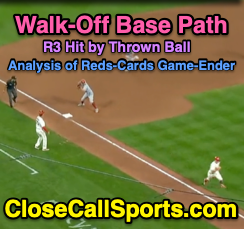When Reds shifted-in outfielder Nick Senzel's throw hit Cardinals runner R3 Andrew Kniznzer in the back, allowing St Louis to score the game winning run to walk off Cincinnati in the 11th inning, with HP Umpire Chad Fairchild signaling baserunner Knizner safe at home, Cincinnati briefly contested the ruling...was this a legal play or should Knizner have been called out for interference, or for some other violation of the rules?
Play: With none out and the bases loaded in the bottom of the 11th inning of a 0-0 game, Cardinals batter Paul Goldschmidt hit a sharp ground ball to the third base position, being played by drawn-in outfielder Senzel, who threw home to try and retire Knizner to keep the game scoreless. The baseball hit Knizner in the back and bounced away, allowing St Louis to score the one and only run of the ballgame.
Analysis of Possible Outs: It is important to note that Knizner began his jaunt to home plate in foul territory before veering to his left and running in fair territory, which is where he was struck by the thrown ball. The reason this is important to note is so one can refer to the base path rules:
The only way a runner may be called for being out of the base path is if they run more than three feet to avoid a tag attempt. No tag? No base path violation. With a thrown ball, there was no tag attempt and thus no base path violation. Reference: Official Baseball Rule 5.09(b)(1).
Instead, the most realistic possibility for an out call here would be to deem that baserunner Knizner intentionally interfered with a throw, the penalty for which is to declare a dead ball, runners return (and, of course, the violating runner is out). However, replays suggest no such infraction occurred as Knizner was already running in fair territory prior to the throw being released and never looked back toward the throw or baseball, suggesting that Knizner did not intentionally attempt to react to the throw by making an unnatural movement to interfere. The runner’s decision to move to fair territory is immaterial to this end simply because the rule concerns interference with a THROW, and because no throw had occurred prior to the runners step across the foul line, the runner logically could not have run in an intentional way to interfere with a throw that did not exist yet. Reference: OBR 5.09(b)(3).
Video as follows:


















